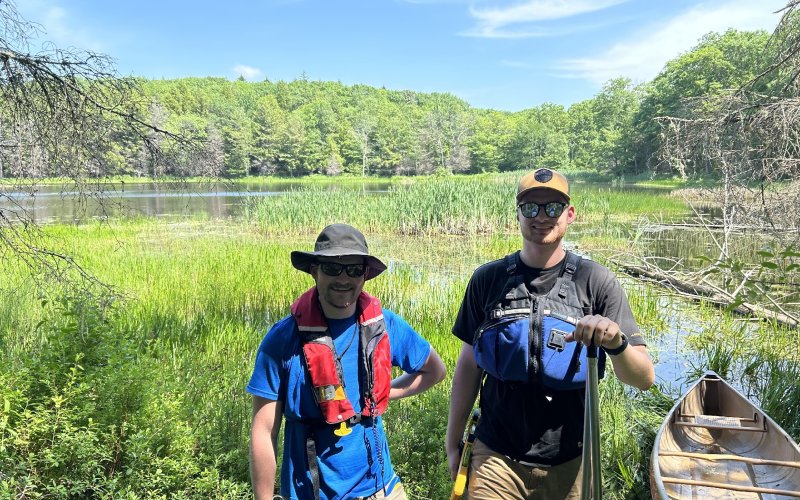Tracking Invasive Fish with the DEC: A Q&A with Evan Walters

By Mike Nolan
ALBANY, N.Y. (Aug. 6, 2024) — Evan Walters is turning his passion for environmental responsibility into action this summer at the New York State Department of Environmental Conservation (DEC).
Walters, a geographic information science (GIS) master’s student in the Department of Geography and Planning, is working with the DEC to better track the distribution and stocking of grass carp, a species of large herbivorous freshwater fish.
Native to eastern Asia, grass carp were introduced to the U.S. in the late 1960s and 1970s to control weed growth in lakes and ponds. While grass carp are useful for isolated bodies of water that have overgrown aquatic vegetation, they can cause harm when wrongfully dumped in non-permitted waterbodies or if the fish spread on their own to other areas through creeks, streams and rivers.
As a DEC intern, Walters is leading a research project to study observational data of grass carp and compare it to the locations in New York where the species is permitted. He’s also sampling the water of areas where they may have possibly spread.
We caught up with Walters to learn more about his summer experience at the DEC and his research interests.
How did you get involved with the DEC?
The DEC is an organization that I’ve always been interested in. I’m passionate about protecting the environment, especially in the beautiful state of New York.
My professional career started with the United States Geological Survey, where I traveled around New York for a summer. When I started graduate school, my advisor, Rui Li, associate professor and program director of UAlbany’s GIS program, made me aware of the job postings by the DEC. I was ecstatic to see all the opportunities that the DEC was offering to students, with some postings being available only to UAlbany students. I was fortunate to be interviewed and considered for a couple of positions. When I received my offer, I couldn’t have been more excited. I have now been working with the DEC for a little over six months, and I have loved every minute of it!
What should people know about grass carp as opposed to the common carp?
Grass carp can be helpful if they are permitted properly and kept only in those locations. When they are used locally, they can eat all nuisance vegetation and make ponds and lakes more visually appealing. They are low cost and aren’t as harmful as chemicals when it comes to aquatic vegetation removal. Their biggest harm comes from their spread into areas where vegetation is a main supporter of a larger ecosystem. The loss of vegetation can alter the oxygen content of the water, which impacts ecologically sensitive species, as well as the natural habitat for native fish.
Grass carp can be identified from the common carp by two main differences — fins and eyes. The dorsal fin (the fin on the top of the fish) is notably shorter on the grass carp than the common carp. The eyes on a grass carp are more aligned in the center of their faces and appear to be more on the side of the head, while the common carp’s eyes sit up higher on the head in a more “normal” spot like other animals and are closer to the front of the head.
Can you tell us more about your summer experience so far?
I’m currently working on publishing a paper that details the objectives of the grass carp project and also meeting DEC officials to discuss the water sampling procedures, which will start in the fall. I’ve been picking up additional projects too, including mapping out the habitat of an invasive plant species, water chestnut. I have also been helping another intern with his aquatic vegetation surveys, where we determine the number of species, as well as the presence of any invasive species in lakes and ponds in the Capital Region. No matter the day, I always find a way to keep busy!
How has your UAlbany education prepared you for this opportunity?
I got my bachelor’s degree in environmental science at UAlbany, with a minor in biology. The environmental science program, as well as the Department of Environmental and Atmospheric Sciences as a whole, had such a wide range of topics available to explore, from geology and ecology to sustainability and climate change. To be honest, I liked them all.
I knew from my undergraduate experience at UAlbany that no matter what field, I wanted to do research for a living. GIS is going to play a large role in the future of environmental research, which makes it a perfect fit for me!
What are your plans for after graduation?
I am hoping to stay in New York, if possible. I can’t imagine moving away from family or this beautiful state. I want to use my education and passion to become a research scientist and help support and maintain the aspects of the environment that make our state so breathtaking.




